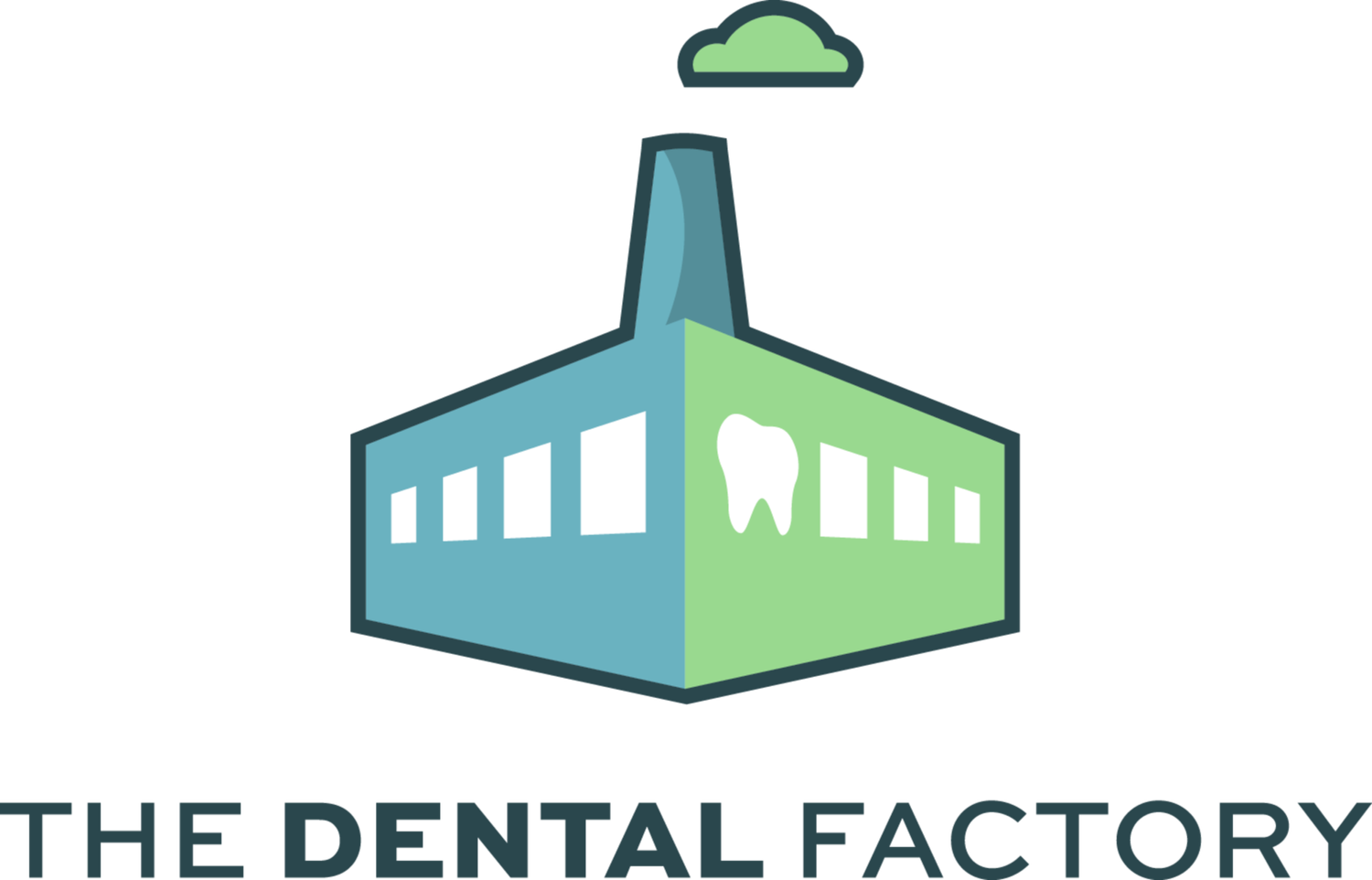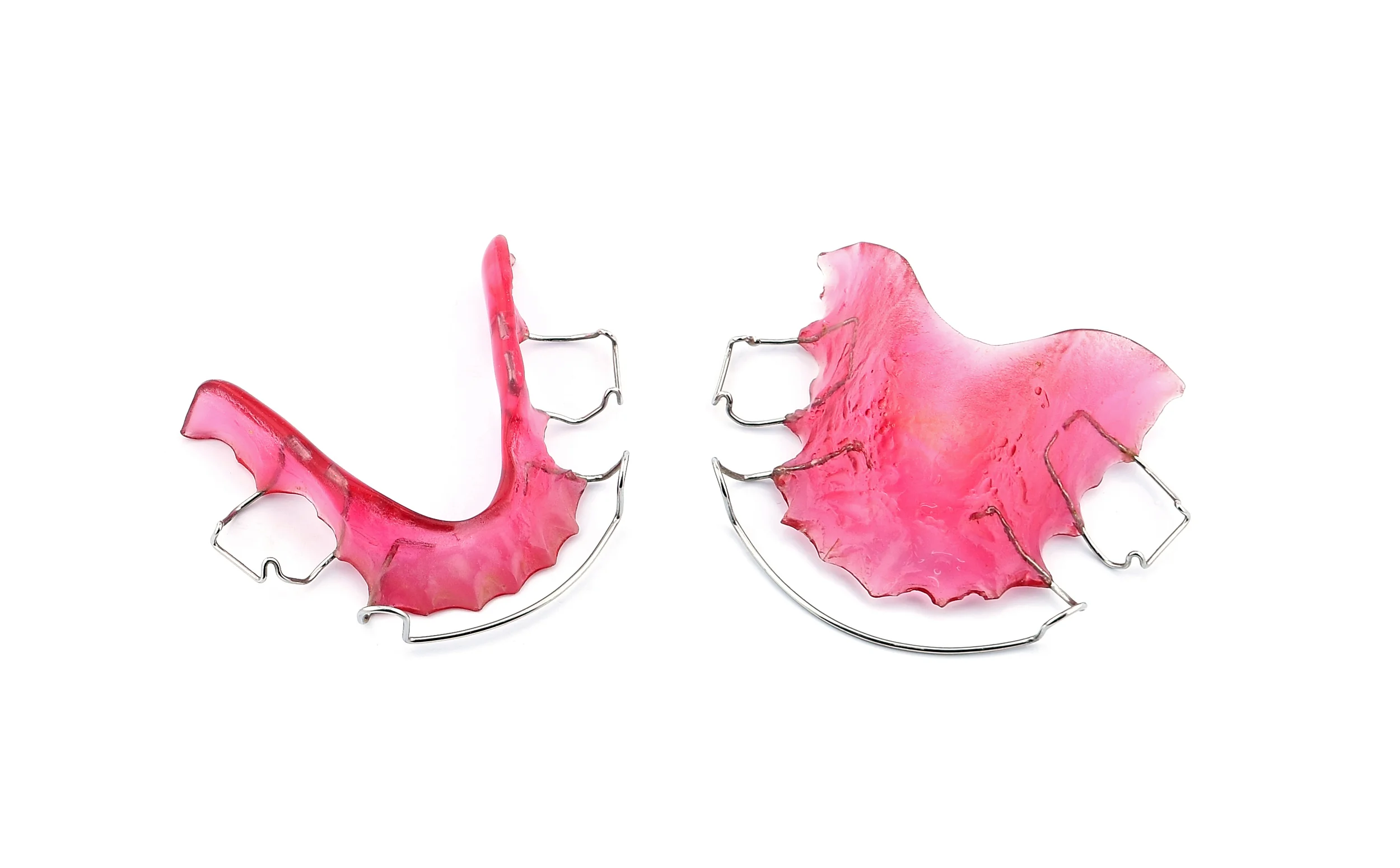Passive Appliances
Retainers
Retainers maintain teeth in the required position and are worn to prevent relapse that may occur after Orthodontic treatment, Dentists must make sure they choose the retainer that is right for a particular treatment. Relapse may also occur between the time impressions are taken and the time a retainer is fabricated. It is therefore preferable not to remove the orthodontic brackets and bands from the molars until placement time. However, regardless of treatment stages, we do work with you to fabricate retainers as soon as they are received in the laboratory as to minimise any relapse.
The Regular Hawley retainer is the most widely used type of retainer. On a stone model, a thin layer of acrylic is applied evenly and precisely. This layer contours the lingual surface of teeth and a labial arch wire is in contact with the buccal aspect of incisors. adjustments can be made with the compensation loops that are placed on either side of the canines.
Fabrication requirements
- Upper stone model
- Lower stone model
- Wax bite in C.O
The “W” 3-3 or 4-4 Hygienic twist flex wire perfectly hugs the lingual aspects of the incisors, canines sometimes premolars, maintaining them in position.
This fixed retaining solution is much simpler for patients when using dental floss.
Active Appliances
Removable Expansion Appliances
Fabricated to be fitted on either the maxillary or mandible, removable expansion appliances are active appliances that stimulate dental movement and, in some cases, bone movement. Many accessories, such as expansion screws and springs and various cribs, can be added to these appliances to lingualise, distalise, mesialise or can move one or more teeth buccally. Each appliance can be modified during treatment. As practitioners are able to assess the expansion gained, they may grind the acrylic appliance as needed in order to control teeth movement. Since young patients often show lack of motivation and autonomy, it is up to their parents and hygienists to encourage and follow their orthodontic treatment.
The 3D screw is fitted allowing both transverse and sagittal expansion. Recommended for symmetric expansion of maxillary arch and protrusion of anteriors. Two activation points allow 3mm protrusive and 6mm bilateral expansion to occur separately. This appliance is generally used to create more space when the relationship between the two maxillaries is inadequate . A labial arch wire can be added to increase anchorage of the appliance and to prevent anterior teeth from tipping.
Extraoral accessories, such as the reverse head gear or face mask, can be added to the appliance to increase its efficiency.
Fabrication requirements
- Upper stone model
- Lower stone model
- Wax bite with 2mm intermolar space
The upper Schwarz is a slow expansion appliance without any occlusal pads, used to correct the maxillary transverse and to stimulate buccal tipping of the lower molars. The Schwarz also helps in creating space to align incisors and reduce crowding. Depending on the Practitioners recommendations the expansion is obtained by activating a screw at a rate of approximately 0.025mm once a week.
Clinical practitioners should closely monitor the relationship between maxillaries. Expansion of the upper lingual cuspids must not cause any buccal crossbite with the lower buccal cuspids but rather exert similar movement on them. The tipping movement of lower molars also has to be monitored. Wearing a lower Schwarz or adding acrylic extensions to the appliance ensures best treatment results.
Fabrication requirements
- Upper stone model
- Lower stone model
- Wax bite in C.O
The Spring Aligner is a retainer that can be used to provide minor corrections to relapsed incisors. For this type of correction, the appliance is fabricated from a stone model were the incisors are separated, then replaced in their desired positions. Therefore, when patients wear their tooth aligner, the acrylic exerts pressure on the teeth, stimulating them to resume their proper positions. crowding to be corrected must be minor.
Note, this appliance can also be used by patients who have never had orthodontic treatment. However, these patients are not as mobile as those who have already been treated, therefor correction movements may be more difficult to obtain and can be more painful for the patient.
When dental corrections are major retention must be increased, acrylic lingual extensions fitted with various clasps added to the appliance. Furthermore, in order to make treatment less painful, the lingual aspect of the appliance can be made more flexible with added springs.
Fabrication requirements
- Upper stone model
- Lower stone model
- Wax bite in C.O
Fan-like expansion appliances are recommended for patients whose arches point somewhat forward. This irregularity is corrected by expanding the anterior segments only using a special screw fitted with a hinge; inverting the hinge provides expansion of the posterior segments.
Fabrication requirements
- Upper stone model
- Lower stone model
- Wax bite with 2mm intermolar space
The ALF (Advanced Lightwire Functional) is an expansion appliance using a continuous light force, wires used in this appliance being very light using a consistent light force over a longer period of time, for the transversal development of the lower and upper arch.
Once installed, this appliance requires fewer office visits and controled examinations.
The ALF shown here allows for the expansion of the upper jawbone. Usually installed to be removable, the appliance can be removed for assessment of its activation.
Functional Appliances
For Class II Relationships, This appliance comprises of two plates adapted on both the Upper and Lower arches which occlusal Ramps are fitted with a 70° inclined plane. Located on the premolars, these ramps promote the mandible to protrude forward. By activating the screw, the arches can be moved one at a time or both at once. Moreover, many accessories can be added to the appliance in order to distalise, lingualise, mesialise or move one or several teeth buccally. Selective grinding of the occlusal pads enables lower posterior teeth to erupt, therefore reducing the vertical overbite. The Twin Block is comfortable to wear and patient friendly. Smaller than other functional appliances, it can also be worn permanently. It has the advantage of enabling the mandible to advance without, however, preventing lateral movements. The appliance makes it easier for patients to speak.
Fabrication requirements
- Upper stone model
- Lower stone model
- Wax protrusion bite
- Maximum 8mm mandibular advancement
- Minimum 5mm interincisor space
The Bionator appliance has become widely accepted as a result of the reliable orthopedic corrections it produces. Advantages of these appliances are their great durability, ease of patient acceptance, and delivery.
- The standard open bite Bionator is designed to aid in correction of Class II malocclusions by maintaining the mandible in an advanced position and guiding the eruption of the posterior teeth. In order to prevent the super eruption of the anterior teeth, the mandibular anteriors are covered with an acrylic cap which comes in contact with the maxillary anteriors.
An expansion screw can be added to maintain a tight fit of the appliance.
- The Close Bite Bionator is designed to aid in correction
of Class II malocclusions and the reduction of an anterior open bite. The latter is achieved by keeping the acrylic coverage over the occlusal surfaces of the posterior teeth. An expansion screw can be added to maintain a tight fit of the appliance.
Fabrication requirements
- Upper stone model
- Lower stone model
- Wax protrusion bite
- Maximum 8mm mandibular advancement
- Minimum 2mm interincisor space
Fixed
The Transpalatal Arch helps maintain obtained expansion or tipping of permanent molars treated with an expansion appliance, removable or fixed. The appliance can be fabricated as a removable option, for patients under fixed orthodontic treatment and for those who need important teeth movement, the removable transpalatal arch provides additional anchorage.
Fabrication requirements
- Upper or lower stone model
- Bands Supplied in Situ
- Option for Post fitted Lab Supplied Bands
The Unilateral band & Loop Space Maintainer is used after premature loss of a primary molar in order to maintain the space for a premolar. It is wire fitted with its ends soldered to the fitted band and the other end resting on the distal surface of a premolar or cuspid.
Fabrication requirements
- Upper or lower stone model
- Band Supplied in Situ
- Option for a Post fitted Lab Supplied Band
Fixed rapid palatal expanders enable separation of the median suture by creating less teeth tipping movement than slow expansion appliances. These expanders are perfect for patients who have less motivation and therefor can be less complaint with treatment and whose teeth require greater and faster expansion. To obtain massive movement, the central expansion screw must be activated twice every day at a rate of 0.025mm, mornings and evenings.
The screw that activates the Hyrax is durable because it needs to be firmly fitted on the lingual part of the bands, which are previously adjusted to the first permanent molars and premolars. Alternatively popular modified versions using only 1st Molar bands with rests on the 1st premolars, are used for more predictable paths of insertion.
Fabrication requirements
- Upper stone model
- Lower stone model
- Wax bite in C.O
The Rickanator is a fixed or fixed/removable appliance comprised of an acrylic anterior inclined plane. The Wearing of the appliance provides mandibular advancement, which corrects a Class II case to a skeletal Class I. If used in conjunction with fixed orthodontic brackets, it will enable simultaneous correction of dental and skeletal alignments. Because of the anterior inclined plane, there is no contact between the upper and lower posterior teeth, which enables the occlusion to open up. By adding occlusal rests to the first and second premolars you can strengthen the appliance lowering risks of breakage.
Because patients are not able to remove their appliances, dentists must monitor the progression of mandibular advancement and clean the soft tissues on a regular basis.
Fabrication requirements
- Upper stone model
- Lower stone model
- Wax protrusion bite
Splints
Mouthguards
Junior Mouthguard, Single layer for children under 16
Fabrication requirements
Upper stone model
Lower stone model
Double Layer, For adults playing a majority of contact sports
Fabrication requirements
Upper stone model
Lower stone model
Wax bite with 3mm-space































Clear Retainers